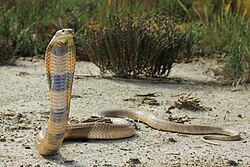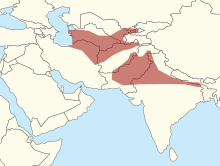Caspian cobra
| Caspian cobra | |
|---|---|

| |
| Scientific classification | |
| Kingdom: | |
| Phylum: | |
| Class: | |
| Order: | |
| Suborder: | |
| Family: | |
| Genus: | |
| Species: | N. oxiana
|
| Binomial name | |
| Naja oxiana | |

| |
| Naja oxiana distribution | |
The Caspian cobra (Naja oxiana), also called the Central Asian cobra, Oxus cobra or Russian cobra, a member of the family Elapidae found in Central Asia.
Description

This species is medium to large in length, a heavy-bodied snake with long cervical ribs capable of expansion to form a hood. The body is compressed dorsoventrally and subcylindrical posteriorly. This species averages about 1 m (3.3 ft)[3] in length and rarely reaches lengths over 1.5 m (4.9 ft).[4] The head is elliptical, depressed, and slightly distinct from the neck, with a short, rounded snout and large nostrils. The eyes are medium in size with round pupils. Dorsal scales are smooth and strongly oblique, with the outer two or three scale rows larger than the remainder.[3] Juveniles tend to be pale, with a faded appearance. They have noticeable dark and light cross-bands of approximately equal width around the body. Adults of this species are completely light to chocolate brown or yellowish, some retain traces of juvenile banding, especially the first few dark ventral bands. This species has no hood mark and no lateral throat spots.[4]
Taxonomic note
Indian cobra (Naja naja) specimens without a hood mark are usually confused with this species, where these two coexist in Pakistan and northern India. The Caspian cobra is never fully black, although some specimens may be quite dark. This species of cobra normally has several dark bands under the throat, whereas in the black phase of Indian cobras (N. naja) from Pakistan, almost the entire throat is black.[5]
Scalation
This cobra has 23 to 27 (usually 25) scale rows around the hood, 19-23 (usually 21) just ahead of midbody, 191-210 ventrals, and 57-71 paired subcaudals; cuneates are often absent.[4]
Distribution
This species occurs in the Transcaspian region. It is found in Turkmenistan, Uzbekistan, Kyrgyzstan, Tadzhikistan, north and east Afghanistan, northeastern Iran, the northern half of Pakistan, from the Kashmir region east to the state of Himachal Pradesh in India, and in southwestern Tajikistan.[3][4]
Habitat
This species is often found in arid and semiarid, rocky or stony, shrub or scrub covered foothills[3] at elevations up to about 3,000 m (9,800 ft) above sea level. This is also the westernmost species of Asiatic cobra.[6]
Behavior and ecology
This species is generally aggressive and bad-tempered. Although they will avoid humans as much as they can, they will become fiercely aggressive when threatened or cornered. Even juveniles tend to be very aggressive. When cornered and provoked, it will spread its hood, hiss, sway from side to side and strike repeatedly; it is not a spitter. This terrestrial species is mainly diurnal, but it may be crepuscular and nocturnal in some parts of its range during the hottest months (July and August). It is a good climber and a good swimmer. It is often found in water and seldom found too far away from it. It feeds on small mammals, amphibians and birds during the evening and early morning. The Caspian cobra will prey mainly on rodents, toads and frogs, occasionally fish, birds and their eggs.[3] Quick-moving and agile, this species lives in holes in embankments or trees.[6]
Venom
Composition
The Caspian cobra is the most venomous species of cobra in the world, slightly ahead of the Philippine cobra, based on a 1992 toxinological study reported in the Indian Journal of Experimental Biology.[7] A number of small nonenzymatic proteins are found in the venom, including neurotoxins and members of the cytotoxin family,[8] which have been shown to cause cell death through damage to lysosomes.[9]
In addition to nonenzymatic proteins, the venom also contains nucleases, which cause tissue damage at the site of the bite and may also potentiate systemic toxicity by releasing free purines in situ.[10] A ribonuclease isolated and purified from Caspian cobra venom, ribonuclease V1, is commonly used as a laboratory reagent in molecular biology experiments due to its unusual ability to break down structured RNA.[11]
Toxic effects
The crude venom of this species has a lowest published lethal dose (LCLo) of 0.005 mg/kg, the lowest among all cobra species, derived from an individual case of poisoning by intracerebroventricular injection.[12] Values for subcutaneous injection average 0.18 mg/kg (range 0.1 mg/kg - 0.26 mg/kg).[7]
The murine subcutaneous LD50 value has been estimated between 0.21 mg/kg[13][verification needed] and 0.4 mg/kg.[14] The intravenous injection route yielded estimates between 0.037 mg/kg[13] and 0.078 mg/kg.[15] Average venom yield per bite for this species is between 75 and 125 mg (dry weight),[3] but can reach up to 590 mg.[16]
The bite of this species may cause severe pain and swelling, along with severe neurotoxicity. Weakness, drowsiness, ataxia, hypotension, and paralysis of throat and limbs may appear in less than one hour after the bite. Without medical treatment, symptoms rapidly worsen and death can occur soon after a bite due to respiratory failure.[6] A woman bitten by this species in northwestern Pakistan suffered severe neurotoxicity and died while en route to the closest hospital nearly 50 minutes after envenomation. Between 1979 and 1987, 136 confirmed bites were attributed to this species in the former Soviet Union. Of the 136, 121 received antivenom, and only four died. Of the 15 who did not receive antivenom, 11 died - a 73% mortality rate.[citation needed] Antivenom is not as effective for envenomation by this species as it is for other Asiatic cobras within the same region, like the Indian cobra (Naja naja), and massive amounts of antivenom are often required for patients. As a result, a monovalent antivenom serum is being developed by the Razi Serum and Vaccine Research Institute in Iran.[15] The untreated mortality rate for this species is approximately 70-75%, which is among the highest of all cobra species of the genus Naja.[17] In both Central Asia[17] and Iran[18] this species is responsible for high rates of snakebites and resulting mortality.
See also
References
- ^ Template:IUCN2014.3
- ^ "Naja oxiana (Eichwald, 1831)". ITIS Standard Report Page. ITIS.gov. Retrieved 13 January 2012.
- ^ a b c d e f "Naja oxiana - General Details, Taxonomy and Biology, Venom, Clinical Effects, Treatment, First Aid, Antivenoms". WCH Clinical Toxinology Resource. University of Adelaide. Retrieved 13 January 2012.
- ^ a b c d "Species of Asiatic Naja". The Asiatic Cobra Systematics Page. Bangor University. Retrieved 13 January 2012.
- ^ "Naja oxiana". Venom Street. Collector and Breeder of Asian Cobras. Venom Street. Retrieved 3 February 2012.
- ^ a b c "Naja oxiana". Armed Forces Pest Management Board. United States Department of Defense. Retrieved 14 January 2012.
- ^ a b Khare, AD; Khole V; Gade PR (December 1992). "Toxicities, LD50 prediction and in vivo neutralisation of some elapid and viperid venoms". Indian Journal of Experimental Biology. 30 (12): 1158–62. PMID 1294479. Retrieved 6 December 2013.
- ^ Dementieva, Daria V.; Bocharov, Eduard V.; Arseniev, Alexander. S. (1999). "Two forms of cytotoxin II (cardiotoxin) from Naja naja oxiana in aqueous solution. Spatial structures with tightly bound water molecules". European Journal of Biochemistry. 263 (1): 152–62. doi:10.1046/j.1432-1327.1999.00478.x. PMID 10429199.
- ^ Sharonov, George V.; Feofanov, Alexei V.; Astapova, Maria V.; Rodionov, Dmitriy I.; Utkin, Yuriy N.; Arseniev, Alexander S. (2005). "Cancer cell injury by cytotoxins from cobra venom is mediated through lysosomal damage". Biochemical Journal. 390 (Pt 1): 11–8. doi:10.1042/BJ20041892. PMC 1184559. PMID 15847607.
- ^ Dhananjaya, B.L.; D'souza, C.J.M. "An overview on nucleases (DNase, RNase, and phosphodiesterase) in snake venoms". Biochemistry (Moscow). 75 (1): 1–6. doi:10.1134/S0006297910010013.
- ^ Ying, Shao Yao (ed.). MicroRNA Protocols. Humana Press. p. 23. Retrieved 28 January 2015.
- ^ Lysz, Thomas W.; Rosenberg, Philip (May 1974). "Convulsant activity of Naja naja oxiana venom and its phospholipase A component". Toxicon. 12 (3): 253–265. doi:10.1016/0041-0101(74)90067-1. PMID 4458108.
- ^ a b Zug, George R. (1996). Snakes in Question: The Smithsonian Answer Book. Washington D.C., USA: Smithsonian Institution Scholarly Press. ISBN 1-56098-648-4.
- ^ Brown, John H. (1973). Toxicology and Pharmacology of Venoms from Poisonous Snakes. Springfield, IL USA: Charles C. Thomas Publishers. p. 82. ISBN 0-398-02808-7.
- ^ a b Akbari, A; Rabiei , H.; Hedayat, A.; Mohammadpour, N.; Zolfagharian, H.; Teimorzadeh, Sh. (June 2010). "Production of effective antivenin to treat cobra snake (Naja naja oxiana) envenoming". Archives of Razi Institute. 65 (1): 33–37. Retrieved 7 December 2013.
- ^ Latifi, M (1984). "Variation in yield and lethality of venoms from Iranian snakes". Toxicon. 22 (3): 373–380. doi:10.1016/0041-0101(84)90081-3. PMID 6474490.
- ^ a b Gopalkrishnakone, Chou, P., LM (1990). Snakes of Medical Importance (Asia-Pacific Region). Singapore: National University of Singapore. ISBN 9971-62-217-3.
{{cite book}}: CS1 maint: multiple names: authors list (link)[page needed] Cite error: The named reference "medsnakes" was defined multiple times with different content (see the help page). - ^ Latifi, Mahmoud (1984). Snakes of Iran. Society for the Study of Amphibians & Reptiles. ISBN 978-0-916984-22-9.
Further reading
- Wüster, Wolfgang (1993). "A century of confusion: Asiatic cobras revisited". Vivarium. 4 (4): 14–8.
- Eichwald, E (1831) Zoologia specialis, quam expositis animalibus tum vivis, tum fossilibus potissimuni rossiae in universum, et poloniae in specie, in usum lectionum publicarum in Universitate Caesarea Vilnensi. Zawadski, Vilnae.
- Wüster, W.; Thorpe, R. S. (1991). "Asiatic cobras: Systematics and snakebite". Experientia. 47 (2): 205–9. doi:10.1007/BF01945429. PMID 2001726.
- Wüster, W.; Thorpe, R. S. (1992). "Asiatic Cobras: Population Systematics of the Naja naja Species Complex (Serpentes: Elapidae) in India and Central Asia". Herpetologica. 48 (1): 69–85. JSTOR 3892921.
- Wüster, Wolfgang (1998). "The cobras of the genus Naja in India". Hamadryad. 23 (1): 15–32.

